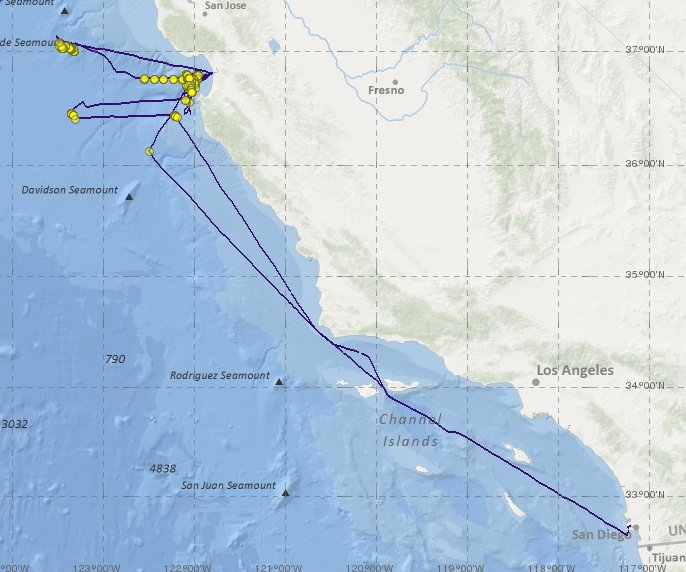CTD station locations from R/V New Horizon NH1008 from the Monterey Bay, near MBARI buoy M1 (36.747?N, 122.022?W); 2010 (GATEKEEPERS project)
Project
| Contributors | Affiliation | Role |
|---|---|---|
| Checkley, David M. | University of California-San Diego Scripps (UCSD-SIO) | Principal Investigator, Contact |
| Dagg, Michael | Louisiana Universities Marine Consortium (LUMCON) | Co-Principal Investigator |
| Jackson, George A. | Texas A&M University (TAMU) | Co-Principal Investigator |
| Gegg, Stephen R. | Woods Hole Oceanographic Institution (WHOI BCO-DMO) | BCO-DMO Data Manager |
Station Id, Date, Time, Lat, Lon and Depth of CTD Stations
Generated from CTD Profile Casts header data (CTD/binned_downcast/XXXhdr.txt files)
BCO-DMO Processing/Edits
- Generated from CTD Profile Casts header data (CTD/binned_downcast/XXXhdr.txt files) contributed by Jessica Forrest-Baldini
- Date reformatted to YYYYMMDD
- Time reformatted to HHMMSS
- ISO DateTime format generated
- Max depth of cast extracted from XXXasc.txt profile files
| File |
|---|
CTD_Stations.csv (Comma Separated Values (.csv), 3.38 KB) MD5:813ff107447009a8b67d5cd5a83f4d72 Primary data file for dataset ID 3710 |
| Parameter | Description | Units |
| CTD_Cast | CTD Cast Number/Id | Dimensionless |
| ISO_DateTime_UTC | CTD Date/Time from Header File (UTC) ISO formatted | YYYY-MM-DDTHH:MM:SS.xxZ |
| Date | CTD Date from Header File (UTC) | YYYYMMDD |
| Time | CTD Time from Header File (UTC) | HHMMSS |
| Latitude | CTD Latitude from Header File (South is negative) | decimal degrees |
| Longitude | CTD Longitude from Header File (West is negative) | decimal degrees |
| Depth | CTD Max depth | meters |
| Dataset-specific Instrument Name | CTD Sea-Bird SBE 911plus |
| Generic Instrument Name | CTD Sea-Bird SBE 911plus |
| Generic Instrument Description | The Sea-Bird SBE 911 plus is a type of CTD instrument package for continuous measurement of conductivity, temperature and pressure. The SBE 911 plus includes the SBE 9plus Underwater Unit and the SBE 11plus Deck Unit (for real-time readout using conductive wire) for deployment from a vessel. The combination of the SBE 9 plus and SBE 11 plus is called a SBE 911 plus. The SBE 9 plus uses Sea-Bird's standard modular temperature and conductivity sensors (SBE 3 plus and SBE 4). The SBE 9 plus CTD can be configured with up to eight auxiliary sensors to measure other parameters including dissolved oxygen, pH, turbidity, fluorescence, light (PAR), light transmission, etc.). more information from Sea-Bird Electronics |
NH1008
| Website | |
| Platform | R/V New Horizon |
| Report | |
| Start Date | 2010-07-08 |
| End Date | 2010-07-25 |
| Description | Collaborative Research: Zooplankton at the Base of the Particle Maximum: Gatekeepers of the Vertical Flux?: Deployment and recovery of SOLOPCs in Monterey Bay, plus CTD and MOCNESS deployments in Monterey Bay
Cruise information and original data are available from the NSF R2R data catalog.
Figure 1. R/V New Horizon Cruise NH1008 GATEKEEPERS
[click on the image to view a larger version] |
Zooplankton feeding at the base of the particle maximum: Gatekeepers of the Vertical Flux? (GATEKEEPERS)
Zooplankton feeding at the base of the particle maximum: Gatekeepers of the Vertical Flux?
A range of observations suggest that zooplankton act as gatekeepers for material leaving the euphotic zone. This study will investigate the interactions of zooplankton with other particles using a suite of autonomous and tethered instruments in conjunction with finescale water sampling. The SOLOPC (Sounding Oceanographic Observer with Laser Optical Plankton Counter) will be the autonomous instrument and provide hourly profiles of zooplankton and other particles. Previous sampling with the SOLOPC indicated a diel cycle of production and abundance of particles in the euphotic zone and their sinking and consumption, presumably by zooplankton observed at the base of the particle abundance maximum. The SOLOPC senses particles, including zooplankton and aggregates, and measures their equivalent spherical diameters which can be used to compute particle size spectra. However, it is difficult to use the SOLOPC to distinguish among particle types, such as copepods, larvaceans, and aggregates, particularly if they are small. The research will include an intensive field study that will take place in Monterey Bay and use adaptive sampling to observe near SOLOPCs with a new, AUV-borne imaging system, ship-based CTD and MOCNESS sampling, and MBARI's ROV Ventana. The investigators will alter a SOLOPC to be stationary relative to an isopycnal and use the particle counts that it accumulates to calculate a flux spectrum. They will combine the flux and concentration spectra to estimate particle sinking velocities as a function of particle diameter. Zooplankton feeding in the water column will be estimated by analyzing the gut fluorescence of animals caught in zooplankton nets and by counting the distribution of fecal pellets in water samples. Results will enhance the understanding of the role of the zooplankton as gatekeepers in the vertical flux of particles and, hence, the biological pump. The study will also provide new insight into factors that affect zooplankton behavior and ecology.
Collaborating institutions include SIO, TAMU, LUMCON, MBARI, BIO, and Université Paris VI. The SOLOPC, modified to measure flux as well as profile, and REFLICS are intended for acquisition and use by other researchers worldwide. The understanding we gain of role of the zooplankton as gatekeepers of the vertical flux will contribute valuably to understanding of the biological pump and the carbon cycle.
PUBLICATIONS PRODUCED AS A RESULT OF THIS RESEARCH
Jackson, GA and DM Checkley Jr. "Particle size distributions in the upper 100 m water column and their implications for animal feeding in the plankton," Deep-Sea Research, 2011.
Figure 1. R/V New Horizon Cruise NH1008 GATEKEEPERS
[click on the image to view a larger version]

| Funding Source | Award |
|---|---|
| NSF Division of Ocean Sciences (NSF OCE) | |
| NSF Division of Ocean Sciences (NSF OCE) | |
| NSF Division of Ocean Sciences (NSF OCE) |
[ table of contents | back to top ]